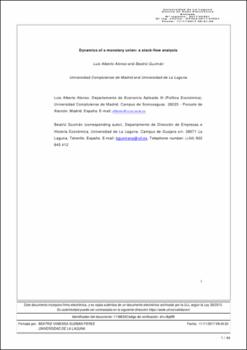Dynamics of a monetary union: a stock-flow analysis
Date
2017Abstract
This paper models the dynamic path of a monetary union comprising two countries. The problems with this union initially arise when inflationary pressures from the member countries differ; the regulation provided by the instruments of common economic policy (common interest rate, extra-union exchange rate) is therefore inadequate for each country on its own. In this case, variations in price competitiveness produced in conjunction with the performance of the central bank ensure that inflation rates in both countries reach their target value. However, this result is achieved by generating permanent foreign deficits that fuel growth in the external debt stock, which in turn acts on the flows that generate it. The aim of this study is to analyse the stock-flow interaction that is unaddressed by the Theory of Optimum Currency Area. Based on the proposed model, criteria distinct from the usual criteria are derived to decide when it is appropriate to establish a monetary union.





